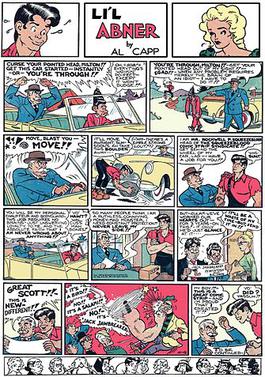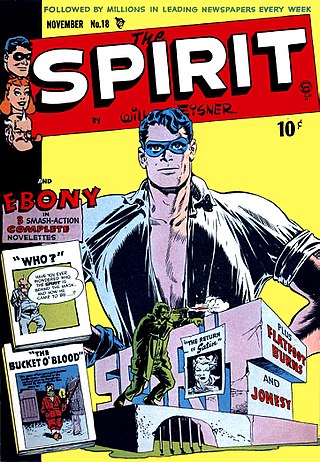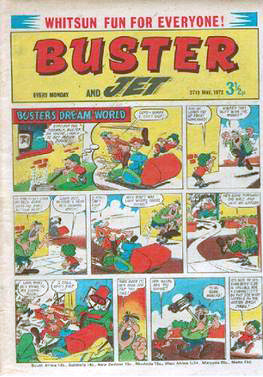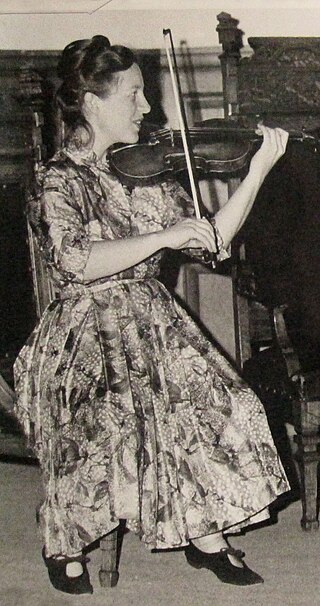
Viz is a British adult comic magazine founded in 1979 by Chris Donald. It parodies British comics of the post-war period, notably The Beano and The Dandy, but with extensive profanity, toilet humour, black comedy, surreal humour and generally sexual or violent storylines. It also sends up tabloid newspapers, with mockeries of articles and letters pages. It features parody competitions and advertisements for overpriced 'limited edition' tat, as well as obsessions with half-forgotten kitsch celebrities from the 1960s to the 1980s, such as Shakin' Stevens and Rodney Bewes. Occasionally, it satirises current affairs and politicians, but it has no particular political standpoint.

Li'l Abner is a satirical American comic strip that appeared across multiple newspapers in the United States, Canada and Europe. It featured a fictional clan of hillbillies in the impoverished mountain village of Dogpatch, USA. Written and drawn by Al Capp (1909–1979), the strip ran for 43 years – from August 13, 1934, through November 13, 1977. The Sunday page debuted six months after the daily, on February 24, 1935. It was originally distributed by United Feature Syndicate and, later by the Chicago Tribune New York News Syndicate.

Achewood is a webcomic created by Chris Onstad in 2001. It portrays the lives of a group of anthropomorphic stuffed toys, robots, and pets. Many of the characters live together in the home of their owner, Chris, at the fictional address of 62 Achewood Court. The events of the strip mostly take place in, and around the house, as well as around the town of Achewood, the fictional suburb which gives its name to the comic.

Blondie is an American comic strip created by cartoonist Chic Young. The comic strip is distributed by King Features Syndicate, and has been published in newspapers since September 8, 1930. The success of the strip, which features the eponymous blonde and her sandwich-loving husband, led to the long-running Blondie film series (1938–1950) and the popular Blondie radio program (1939–1950).

Fritz the Cat is a comic strip created by Robert Crumb. Set in a "supercity" of anthropomorphic animals, it focused on Fritz, a tabby cat who frequently went on wild adventures that sometimes involved sexual escapades. Crumb began drawing the character in homemade comic books as a child. Fritz became one of his best-known characters, thanks largely to the motion picture adaptation by Ralph Bakshi.

The Spirit is a fictional masked crimefighter created by cartoonist Will Eisner. He first appeared June 2, 1940, as the main feature of a 16-page, tabloid-sized, newsprint comic book insert distributed in the Sunday edition of Register and Tribune Syndicate newspapers; it was ultimately carried by 20 Sunday newspapers, with a combined circulation of five million copies during the 1940s. "The Spirit Section", as the insert was popularly known, continued until October 5, 1952. It generally included two other four-page strips, plus filler material. Eisner, the overall editor, wrote and drew most Spirit entries, with the uncredited assistance of his studio of assistants and collaborators, though with Eisner's singular vision a unifying factor.

Buster was a British comic which began publication in 1960, originally published by IPC Magazines Ltd under the company's comics division Fleetway, then by Egmont UK Ltd under the same imprint until its closure in 2000. Despite missing issues due to industrial action during its run, the comic published 1,902 issues in total. The comic carried a mixture of humour and adventure strips, featuring the title character Buster and a host of other characters.

The milanesa is a variation of the Lombard veal Milanese, or the Austrian Wiener Schnitzel, where generic types of meat breaded cutlet preparations are known as a milanesa.

Captain Midnight is a U.S. adventure franchise first broadcast as a radio serial from 1938 to 1949. The character's popularity throughout the 1940s and into the mid-1950s extended to serial films (1942), a television show (1954–1956), a syndicated newspaper strip, and a comic book title (1942–1948).
Spider Widow is a fictional superhero character that was published by Quality Comics during the Golden Age of Comic Books. The character was created by writer and artist Frank Borth, and debuted in Feature Comics #57, which bore a cover date of June 1942. Borth continued to write and draw the Spider Widow feature until the end of its run in Feature Comics #72.

The Newspaper Enterprise Association (NEA) is an editorial column and comic strip newspaper syndication service based in the United States and established in 1902. The oldest syndicate still in operation, the NEA was originally a secondary news service to the Scripps Howard News Service; it later evolved into a general syndicate best known for syndicating the comic strips Alley Oop, Our Boarding House, Freckles and His Friends, The Born Loser, Frank and Ernest, and Captain Easy / Wash Tubbs; in addition to an annual Christmas comic strip. Along with United Feature Syndicate, the NEA was part of United Media from 1978 to 2011, and is now a division of Andrews McMeel Syndication. The NEA once selected college All-America teams, and presented awards in professional football and professional [NBA] basketball.

Terry LaBan is an alternative/underground cartoonist and newspaper comic strip artist. He is known for his comic book series Cud, and his syndicated strip Edge City, created with his wife, Patty LaBan, a couples and family therapist.

Jane's World was a comic strip by cartoonist Paige Braddock that ran from March 1998 to October 2018. Featuring lesbian and bisexual women characters, the strip stars Jane Wyatt, a young lesbian living in a trailer in Northern California with her straight male roommate, Ethan, and follows her life with her circle of friends, romances, and exes. Shortly after celebrating its 20th anniversary, publication ended with Jane marrying Dorothy.

William Woggon was an American cartoonist who created the comic book Katy Keene.

Pupung is a daily comic strip created by Filipino cartoonist Washington "Tonton" Young. Appearing in the broadsheet Manila Bulletin, the strip revolves around its title character, a young boy, and his family and household. Pupung's family maintains a lugawan, a restaurant which mainly serves rice congee dishes.
Baby Crockett was one of the longest running comic strips that ran from The Beezer issue 34 to Beezer 1809. He continued in the merged Beezer and Topper until its demise in 1993, and would appear in all the Beezer annuals and summer specials until they ended in 2002. He also appeared in several of the Dandy Comic Libraries over the years.
Albert Hermann Vermeer (1911–1980), known as Al Vermeer, was an American cartoonist. Vermeer created the comic strip Priscilla's Pop.

Priscilla McClure Paetsch, , was an American violinist, composer, artist, sculptor, horse trainer, and co-founder of the Paetsch Family Chamber Music Ensemble in Colorado Springs, Colorado. She was the wife of cellist Günther Johannes Paetsch and the mother to their seven children.
Silly Symphony, initially titled Silly Symphonies, is a weekly Disney comic strip that debuted on January 10, 1932 as a topper for the Mickey Mouse strip's Sunday page. The strip featured adaptations of Walt Disney's popular short film series, Silly Symphony, which released 75 cartoons from 1929 to 1939, as well as other cartoons and animated films. The comic strip outlived its parent series by six years, ending on October 7, 1945.
Uncle Remus and His Tales of Br'er Rabbit is an American Disney comic strip that ran on Sundays from October 14, 1945, to December 31, 1972. It first appeared as a topper strip for the Mickey Mouse Sunday page, but after the first few years, almost always appeared on its own. The strip replaced the 1932-1945 Silly Symphony strip, which had spent its final year on gag strips featuring Panchito from The Three Caballeros.















